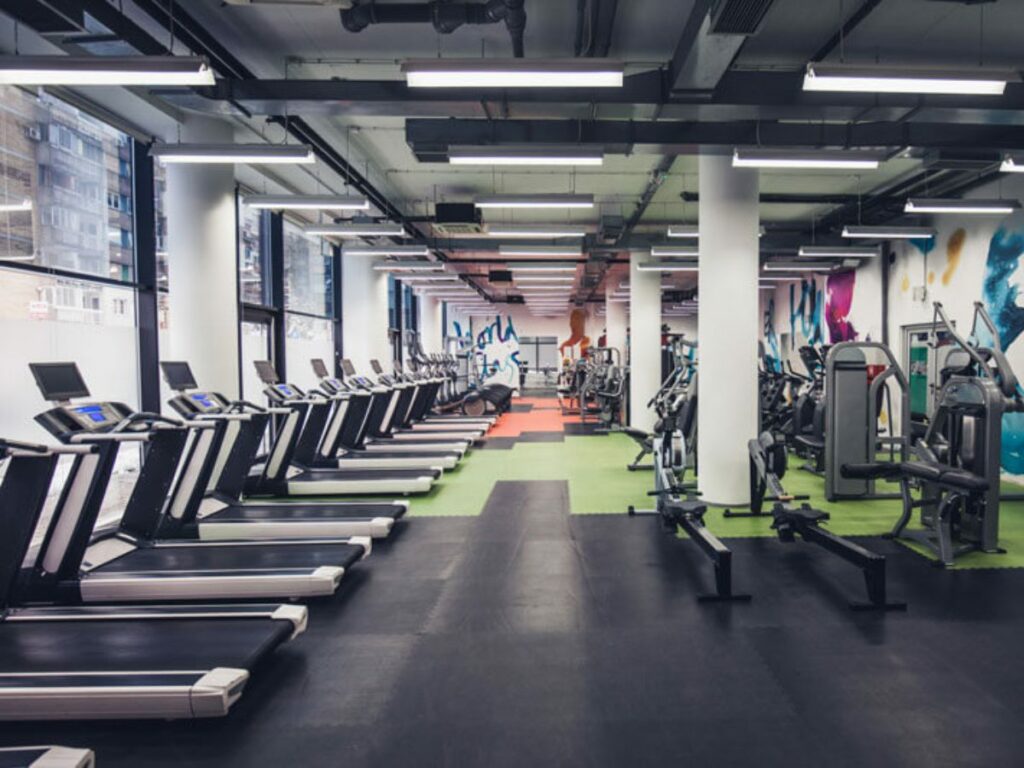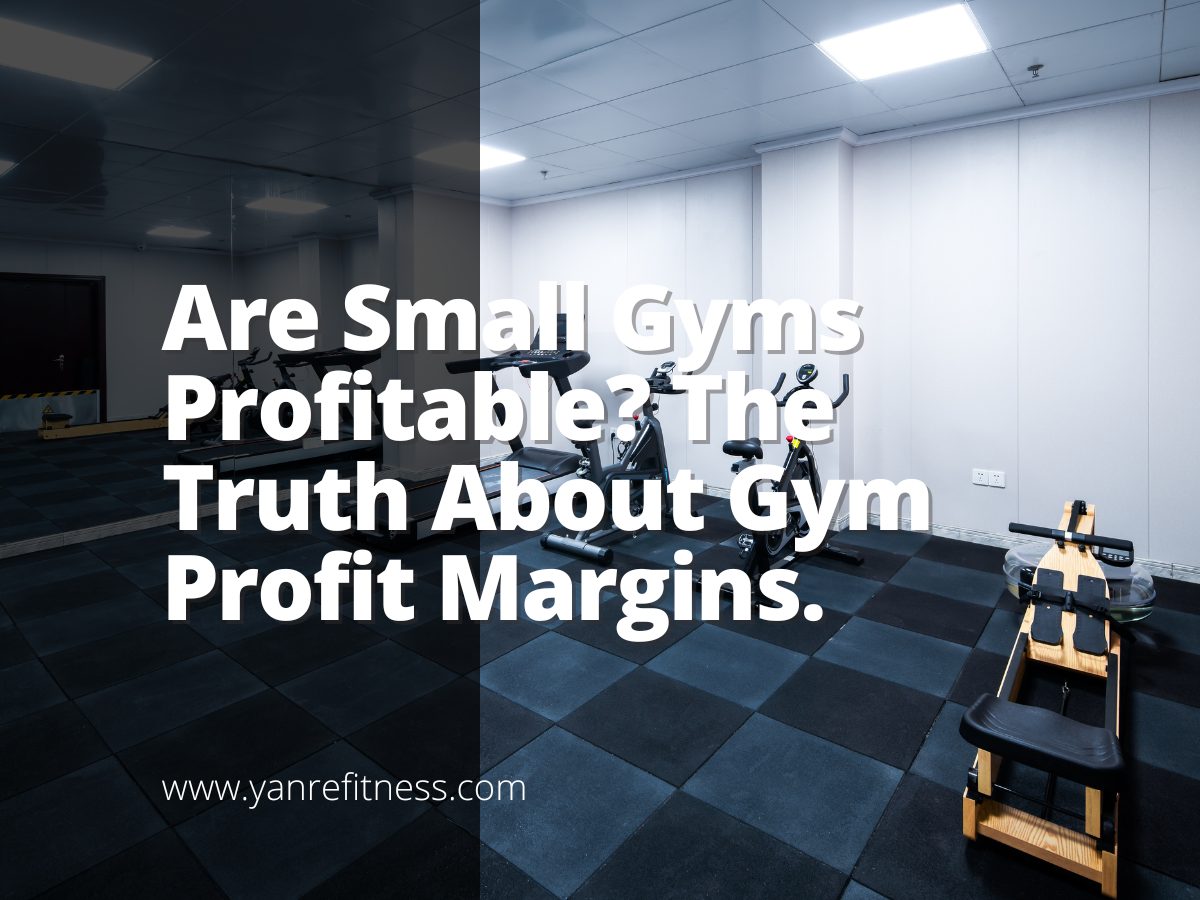Are you dreaming of launching a small gym but worried about potential revenue? It’s a common concern, especially given the high market competition. However, understanding the profitability of independently-owned, smaller-scale fitness centers is crucial to alleviate those worries.
Absolutely small gyms can be profitable with careful planning and effective management, and by implementing the right pricing strategies and unique services, small gyms have the potential to build a dedicated customer base, subsequently boosting profits. As we delve into this blog, we’ll unmask the truth behind gym profit margins.
Dive in and read on!
Table of Contents
1. The Average Profit of a Small Gym
Gym owners venture into the fitness business with aspirations of turning passion into profits. With a surge in health awareness, small gyms have become lucrative businesses. The profit a small gym can generate largely depends on various elements such as location, services offered, and type of gym.
A study divulge that worth nearly 160 billion in 2021, the fitness industry is expected to grow 171.75% to 434.74 billion USD by 2028. Furthermore, the type of gym significantly affects profit margins. I have seen boutique fitness studios can have profit margins between 20-40%, while traditional gyms tend to average around 10-15%. Knowing these figures is crucial for setting realistic expectations.

2. How Do Gyms Make Money
In my viewpoint, it is also important to focus on gaining higher revenue from fitness gyms. Gyms make money from a variety of sources that allows them to operate on a regular basis. Here are the ways that gyms generate revenue:
Membership
Gyms primarily generate revenue through memberships. People sign up for memberships which usually involve paying a monthly or annual fee. These membership fees are the lifeblood of a gym as they provide a consistent stream of income.

Online Fitness Classes
According to Grand View Research, the global virtual fitness market size was valued at USD 16.4 billion in 2022 and is expected to expand at a compound annual growth rate (CAGR) of 26.72% from 2023 to 2030. There are many benefits to offering online fitness classes and challenges, including convenience, flexibility, and the ability to reach a wider audience.
- Virtual H.I.I.T. Classes
Offer virtual High-Intensity Interval Training classes that engage participants through fast-paced workouts. The classes should be easy to follow and adapt to varying fitness levels. Instructors need to ensure they are attentive to participants’ posture and form even through video calls.
- Live One-On-One Personal Training
These classes replicate the experience of having a personal trainer, but everything happens online. The instructor and participant can be in different locations, and through live video, the trainer guides the participant through a tailored fitness regimen.
- Online Yoga Classes
Yoga classes are popular for their physical and mental health benefits. Instructors should provide clear guidance, focusing on correct postures and the muscles involved. Online classes can start with warm-ups and progress to more challenging poses.
- Recorded Group Sessions
This format allows the instructor to record a workout session, which can then be shared with a group. The participants have the flexibility to access the workout at their convenience. This could include various forms of exercise, from aerobics to strength training. Small gym owners can also use technology to scale this concept by offering these sessions via mobile fitness apps which is more accessible to clients.

Selling Gym Merchandise
In addition to memberships and classes, some gym business owners sell merchandise. This can include anything from branded clothing, workout gear, nutritional supplements, or equipment. For fitness equipment, I can vouch for Yanre Fitness. Having gym merchandise not only creates an additional revenue stream but also serves as a marketing tool, as members wearing the branded gear act as walking advertisements.

Offer Discounts to Members
Gyms businesses have started realizing the power of customer retention through memorable experiences. Offering discounts to members is one way to make the experience memorable and encourage repeat business. For instance, companies can offer corporate passes to attractions as employee perks, which not only boost morale but can also serve as a member discount strategy.

Adding a Concession Space
One innovative approach gyms can adopt is adding concession spaces within their premises. This allows gyms to lease out spaces to complementary businesses such as juice bars, beauty salons, or sports goods vendors. For example, a juice bar within the gym premises offers members the convenience to grab a healthy drink post-workout.
Right Partnerships
For a gym, making the right partnerships can lead to mutual growth and success. Partnerships could be with fitness influencers, nutritionists, local businesses, or even other gyms. For example, partnering with a popular fitness influencer could bring more visibility and credibility to the gym. Similarly, collaborating with nutritionists can offer diet plans and consultations, adding more value to memberships.
3. Factors Affecting Profitability
Running a small gym can be a rewarding business venture, but it’s important to understand the factors that can affect its profitability for you to easily address any of these if ever you encounter difficulties in operating your gym. Here are the following factors:
Facilities and Equipment
The quality of the gym’s facilities and equipment can impact membership retention rates. Here’s the interesting part, keeping every piece of equipment up to date and maintaining a clean and inviting environment can help attract and retain members, which can increase the gym’s profit. Choose Yanre Fitness gym equipment – long-lasting and quality proven.

Costs
Managing costs effectively is crucial for the profitability of a gym. Expenses can include rent, utility bills, equipment maintenance, and staff wages. It is vital to keep a close eye on these outlays and develop strategies to minimize them without compromising the quality of services. A failure to cover operating expenses can quickly lead to financial problems, as underpricing services may not sufficiently cover these costs

Gym Memberships
Developing attractive and diverse membership plans is key. Some gyms offer multiple-tier pricing, whereas more expensive plans may include extra services such as free training classes or nutrition planning. I see a strategic approach to pricing gym memberships can maximize customer conversions and, subsequently, revenue and profitability.

Staffing
Well-trained instructors and personal trainers add value to the services offered, enhancing customer satisfaction. Investing in staff development and ensuring that they are appropriately compensated is vital. My point is, the quality of the staff will also reflect on the gym’s reputation, playing a significant role in attracting and retaining clients.

Marketing and Promotions
In a competitive market, marketing and promotions are indispensable in attracting new members. Effective marketing strategies include both online and offline campaigns that highlight the unique features and offerings of the gym. I can vouch running promotions and special offers may entice prospective members to join.

Costs of Operating a Gym
- Physical Building
The cost of the physical space is one of the largest expenses when running a gym. This includes the cost of leasing or buying the property. If leasing, a security deposit equivalent to 3-6 months of rent is usually required. Depending on the location and size of the building, the average cost for a security deposit can range from $5,000 to $10,000.
- Legal Fees and Taxes
Legal fees and taxes are often overlooked but necessary expenses when running a gym. I can personally tell, the legal fees will be higher at the start and may vary depending on the complexity of the business structure and agreements.
- Capex
Capital expenditures (Capex) would include any investments made in the physical assets of the gym, such as purchasing equipment, or making improvements to the facility. The size and location of the gym can significantly impact these costs.
- Advertising
Creating a strong sense of community and building relationships with members can be a form of advertising. For example, Homeground Gym created the #HomeSquad community. Investing in advertising is vital for attracting members. This can include social media advertising, flyers, and promotions.
- Utilities and Janitorial Services
Utilities, including energy and gas, can add up. It’s important to estimate utility expenses and include them in the budget. Additionally, maintaining a clean and hygienic environment is essential for any gym. Thus, janitorial services are another recurring expense that needs to be accounted for.
- Bookkeeping
Maintaining accurate records and managing finances efficiently is imperative for running a gym. Hiring an accountant or using accounting software can incur costs, but it’s an important investment for monitoring the financial health of the business. This will enable gym owners to make informed decisions about scaling operations, reinvesting profits, and maintaining sustainability in the long run.
- Insurance
General liability insurance is necessary to protect the business in case of accidents. Other types of insurance such as workers’ compensation and theft protection may also be needed. Speaking from experience, the average cost for insurance can range from $500 to $1,500.
Gym’s typical turnover rate
In the bustling world of fitness, gyms are subject to a typical turnover rate. According to Statista, 52% of gyms operational for less than 3 years were profitable in 2020, while 68% of those operational for 8 years made profits. Nevertheless, innovation and diversification of services, such as online classes and nutrition planning, could help in minimizing the turnover rate and increase profitability.
The table below presents insights into the typical turnover rate and profitability of gyms based on their operational duration. Explore how factors such as innovation, diversification of services, member retention, and financial planning impact gym profitability, and discover strategies to minimize turnover rates and drive long-term financial success.
| Gym Turnover Rate and Profitability | Description |
| Gym Operational Duration | The table considers the profitability of gyms based on their operational duration. According to Statista, 52% of gyms operational for less than 3 years were profitable in 2020, while 68% of those operational for 8 years made profits. This data highlights the correlation between the gym’s longevity and its potential for profitability. |
| Factors Affecting Profitability | Factors such as innovation and diversification of services play a crucial role in minimizing the turnover rate and increasing profitability. Incorporating online classes, nutrition planning, and other value-added services can attract a broader range of customers, enhance member satisfaction, and boost revenue streams, ultimately improving the gym’s financial performance. |
| Market Competition and Differentiation | The level of market competition also influences gym profitability. By differentiating themselves from competitors through unique offerings, exceptional customer service, and targeted marketing strategies, gyms can attract and retain customers, leading to higher profitability and reduced turnover rates. |
| Member Retention and Satisfaction | Maintaining a high level of member retention and satisfaction is vital for gym profitability. By providing excellent facilities, well-designed programs, qualified staff, and a positive gym environment, gyms can build strong relationships with members, increase customer loyalty, and reduce turnover rates, ultimately driving profitability. |
| Financial Planning and Cost Management | Effective financial planning and cost management strategies are essential for gym profitability. This includes managing operating expenses, optimizing revenue streams, implementing cost-effective marketing campaigns, and ensuring efficient utilization of resources, ultimately contributing to increased profitability and long-term sustainability. |
| Market Trends and Adaptability | Keeping up with market trends and consumer demands is crucial for gym profitability. By adapting to changing preferences and offering innovative fitness solutions, gyms can attract and retain a larger customer base, stay competitive, and improve their financial performance, reducing turnover rates and increasing profitability. |
Forecasting Gym Revenues
The bulk of revenue generally comes from membership fees, which can be calculated by multiplying the number of members by the average membership fee. (Membership revenues = Members x Membership fee)
Another significant source of income is classes. To calculate revenue from classes, one needs to multiply the number of classes by the average price per class. Including multiple revenue streams, such as online classes and nutrition planning, can further enhance earning potential (Classes revenues = Classes x Average class price)
Forecasting Gym Expenses
- Variable expenses: These changes are based on the number of members and may include supplies and hourly wages. A company’s variable costs increase as the production volume goes up, and they decrease when the production volume goes down.
- Fixed expenses: These remain constant regardless of membership numbers and include rent, utilities, and salaries for full-time staff. Having fixed expenses in the budget is beneficial for planning, as these expenses are more or less constant, making budgeting more predictable
Calculating Gym Profits
Calculating profits when opening a gym involves subtracting total expenses from total revenues. Understanding the profit margin is key, fitness-only clubs registered an average profit margin of 20%. Keeping an eye on the bottom line helps in making informed decisions and ensuring the financial health of the gym business. Proper forecasting and expense management can significantly affect the profitability of a gym.
4. 5 Tips for Maximizing Profitability
As a business owner, I understand how it is likely to look for ways to increase profitability and grow the business. Here are some tips to help increase the profitability of a small gym:
#1 Prioritize Personal Training
Personal training sessions can significantly contribute to the overall revenue. I have seen when clients receive one-on-one attention, their satisfaction levels rise, leading to higher retention rates. This dedicated service allows trainers to customize fitness plans tailored to individual goals, thus establishing a loyal clientele interested in knowing if opening a gym is profitable.
#2 Increase Pricing
Thoughtful price adjustment plays a crucial role in revenue generation. However, it’s vital to be cautious, as steep increases might deter clients. Instead, consider a modest rise, reflecting the quality of services offered. Regular assessment of costs and customer feedback can provide valuable insights, guiding the optimization of the pricing structure.
#3 Sell More Add-Ons
Gyms and fitness centers should explore the potential of selling add-ons like branded merchandise, nutritional supplements, or guest passes, like what other gym owners do. These additional items not only generate more revenue but also enhance the overall client experience.
#4 Analyze Your Competition
Staying informed about competitors’ strategies and offerings is crucial. By understanding what rival gyms are doing successfully, adjustments can be made to attract and retain clients. Analyzing the competition is essential for staying ahead and ensuring the business adapts to changing market demands
Here is a table that can help in analyzing the competition and identifying areas of improvement for the gym:
| Competitor’s Gym | Services Offered | Equipment Available | Unique Features | Pricing |
| Gym A | Personal training, group classes, sauna | Latest cardio and weightlifting machines | Childcare facility, smoothie bar | $XX/month |
| Gym B | Yoga classes, nutrition counseling | Outdoor workout area, functional training equipment | On-site physical therapist, rooftop pool | $XX/month |
| Gym C | CrossFit classes, sports-specific training | Olympic lifting platforms, battle ropes, climbing wall | Cryotherapy chamber, recovery lounge | $XX/month |
| Gym D | Pilates reformer classes, meditation room | Suspension trainers, TRX bands | Infrared sauna, complimentary towel service | $XX/month |
| Your Gym | Personal training, group classes, sauna | Variety of cardio and weightlifting machines | Smoothie bar, outdoor bootcamp area | $XX/month |
#5 Renovate Changing Areas
Investing in the renovation of changing areas can greatly improve the ambiance of the facility. Clean, modern, and well-equipped changing rooms reflect the commitment to providing high-quality services. Such enhancements contribute to a positive customer experience, encouraging existing members to continue their memberships and attracting new clients who value a comfortable and aesthetically pleasing environment.
Conclusion
The exploration into the profitability of small gyms brings us to a verdict – Yes, they can be profitable! A detailed and meticulous approach to business planning, pricing strategy, and unique service offerings can make small gyms attract a loyal customer base and enhance profitability.
How can the flourishing small gym market benefit or complement existing ventures? Yanre Fitness invites interested enterprises to explore a treasure of opportunities. With an array of high-quality, cost-effective gym equipment, we call on firms to join tapping into the small gyms segment. Any queries or suggestions are welcome. Reach out and discover how we can collaborate for a mutually profitable future. Contact us today!
Related articles:








